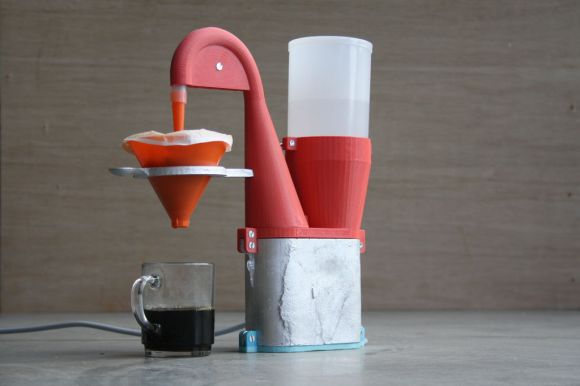
This DIY electric coffeemaker prototype uses an assemblage of 3D-printed parts and cast aluminium. [siemenc]’s main goal with this project was to utilize and demonstrate recycling and re-usability. He used Filabot filament exclusively and melted down scrap aluminium such as cans, foil, and CNC mill waste in an oven he fashioned from an old fire extinguisher. He also cast the aluminium parts himself from 3D-printed positives.
Of course, he had to buy the things that make this a coffeemaker such as the hoses, the fuse, and the heating element. If you’re wondering why he didn’t salvage these parts from yard sale machinery, it’s because he wanted to be able to replace any part of it and have it last as long as he needs it to last. The innards he used are not specific to any model, so he should be able to easily find a replacement.
Just like a pour over set up, [siemenc] has fine control over the strength and quantity of the brew. We particularly like this machine’s exotic bird looks as well; it may be a prototype, but it’s quite stylish. If you’re looking to go all the way with DIY coffee, why not grow your own beans and then roast the beans yourself?
















I love this! (Despite being a big tea drinker haha)
A great use for a 3d printer! Often people forget that you can print molds and positives for casting, obviously it may not be perfect but its an easy way to produce metal parts.
Might be worth experimenting with tolerances and adding extra material so once cast you can file or sand down burrs. Would look amazing all polished and neat but also impressive with a raw cast finish.
I hope the material is food safe… You’ll never know what nasty chemical (e.g. plasticizer and impurities in metal) would be leeching out of your printed plastic and recycled aluminium parts.
From the looks of the build in the link, all the printed and aluminium parts are just for the structure, with the water only passing through the bought and presumebly food safe components like the tank, tubing and heater.
I’d possibly be worried about the base becoming hot to touch, but otherwise it looks awesome, would be even better if I drank coffee :P.
What sort of impurities in Aluminum do you imagine standing up to the +1200F(660C) melting point of aluminum? There might be some binder residues from the mold sand but that should be removed after a trip through the dishwasher or soak in simple green.
Oh, the things we do for coffee!
It’s funny how difficult it is to just grind coffee properly.
Most yard sale coffee makers are very similar internally, and the heating element is almost always the same size (it is generally very close in diameter to the metal plate the pot rests on) so making one that could be repaired from scavenged parts wouldn’t be so difficult.
The MAIN reason you want to buy a new part is scavenged ones will have a ton of calcium salts, particularly in areas with hard water.
OTOH, I just picked up a replacement 12C coffee maker for $9 at Big Lots…this is a LOT more in time/materials/effort for a 1 C coffee maker. A fun ‘Can I learn it?’ project and a hella nice hack, tho.
Am I seeing the same thing as the rest of you? That thing is uglier than fifty smashed assholes in a rusty cast-iron pan.
I agree. I don’t really see the point of casting aluminium for that case. It doesn’t make it look better or work better. It would make more sense to print the whole casing in plastic (like commercial coffee makers) and maybe make the actual heating U-pipe out of aluminium if you really need to to through all that trouble of moulding and casting.
It looks to me like a design student’s final project. Hence the cast aluminium when it wasn’t needed, the artsy look of it, and the focus on recycling.
a little time with some grinder wheels and polishing compound and it would be gorgeous… but then you wouldn’t be able to tell that it was eco-friendly. Maybe V2 will look better. That said, it seems to work, and that’s the most important of the design criteria.
french press? KISS?
My electric tea kettle and pour-over doohickey are my KISS method. Still, props to the guy for the effort.